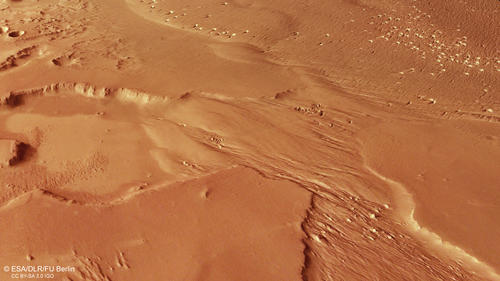Utopia Planitia - Frozen Beauty
Mantled deposits are thick layers of ice- and dust-rich materials that are thought to have been deposited as snow at times when the angle of the tilt of Mars’ rotational axis was much higher, which last happened around 10 million years ago. As the name suggests, this dust/ice mixture covers and smoothens the surface like a mantle. It is very well visible as large patches at the left and right side of the image. The large impact craters in the image center display a double-layered ejecta blanket and at a closer look, the layered appearance of the mantling deposits can be seen at the crater rims and especially in the interior of the impact craters. Here it is called concentric crater fill and is also be found in the smaller craters around. The second largest crater in the image center showcases the typical so-called brain texture of the mantling with concentric deformation and locally the degradation by scallops and small pits.
Just to the right of the brain textured crater, a pattern is faintly visible in the dark colored regions. This pattern originates from fracturing by thermal contraction, which created a polygonal patterned ground. Wind-blown dark dust is trapped in the cracks and responsible for the dark coloration of this region.
Scalloped depressions are omnipresent throughout the image. They have circular to elliptical shapes and their size varies between tens of meters to several kilometers and depth of several tens of meters. They are the result of ground ice melting or its sublimation, followed by collapse of the surface. The process of subsidence by ice loss in the subsurface is called Thermokarst. At closer look, the layering of the mantled deposits can also be seen in and around the scalloped depressions.
Utopia Planitia is one of three major topographic basins in the northern hemisphere of Mars and shows a diameter 3,300 km. It is interpreted to represent an ancient impact basin, that was variably filled by a mix of sediments, volatiles and lavas, transported by water, wind and other processes. Ice in the subsurface has been confirmed by spectral measurements of the hydrogen abundance and directly by the Phoenix lander. Ground ice at greater depth has been detected by observations of fresh impact craters and sublimation pits, as well as by radar sounding.
» back to press release
